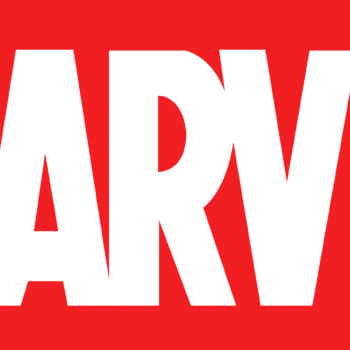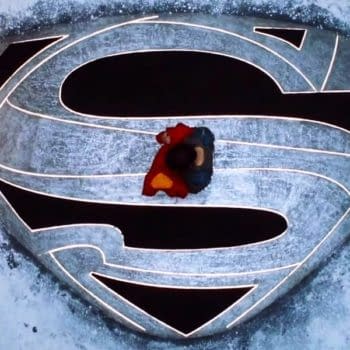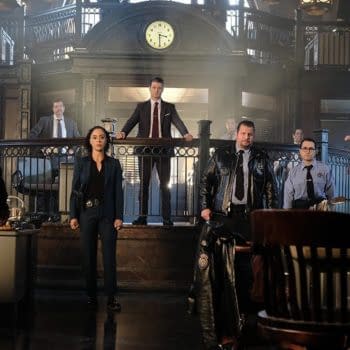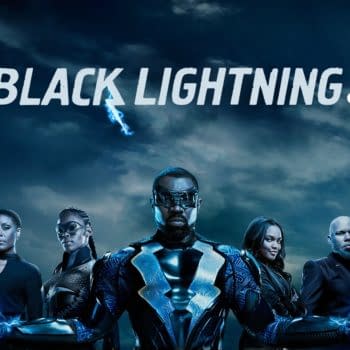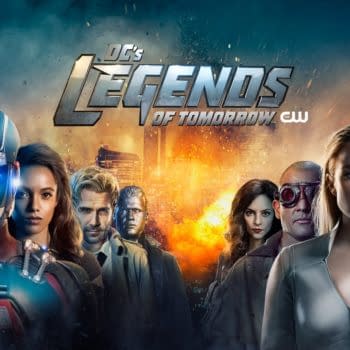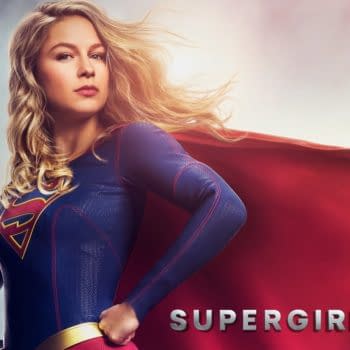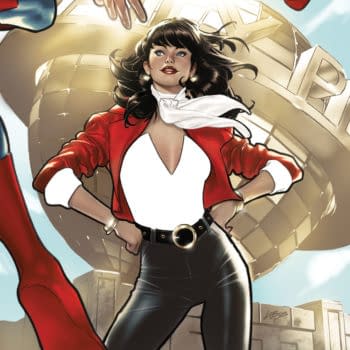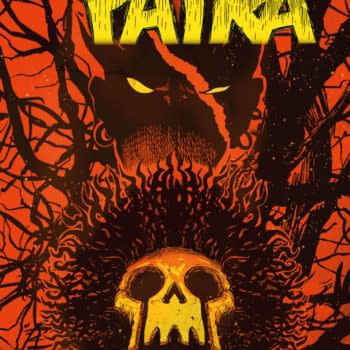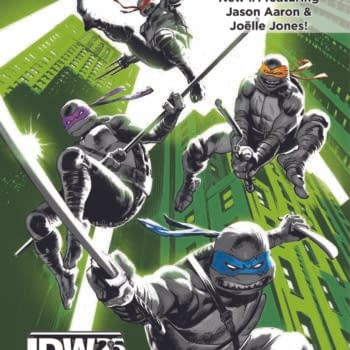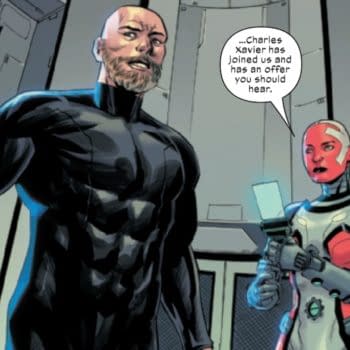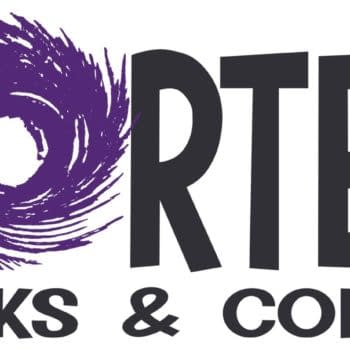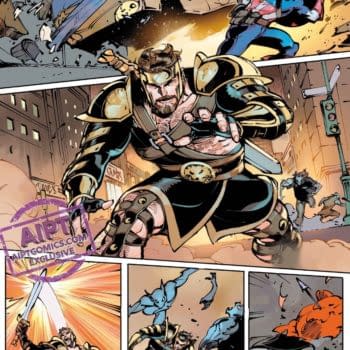Posted in: Comics | Tagged: Best Wishes, Comics, dark horse, entertainment, HRL, mike richardson, paul chadwick
Mike Richardson And Paul Chadwick Talk Their Original Graphic Novel 'Best Wishes'
Hitting comic shops this week from Dark Horse is the new graphic novel Best Wishes from Mike Richardson and Paul Chadwick. It tells the story of two strangers who toss coins into a fountain at the same time, intertwining their lives and dreams in a tale of fame, love, and New York City. I talked with the creators about the original graphic novel, how it came about, and the process of working together.
DAN WICKLINE: Let's start off by talking about the premise of the book. A fountain is imported to New York where a pair of strangers make wishes at the same time and their lives become intertwined. Where did the initial idea for the story come from, and how long did it take to put together? Was this something that just fell into place or grew over time?

Paul Chadwick: I think a visit to a village in Italy with a coin-strewn fountain first got Mike Richardson's gears turning. He wrote a short treatment, which I presume may have started as a movie pitch. It certainly has the clarity such pitches need. Their wishes are mixed up when the coins touch, and each receives the other's heart's desire. I think everyone can see the dramatic and comedic potential in that.
DW: Did these characters change from your initial concept, or did they stick close to what you initially envisioned?
MR: The characters and their personalities were established from the beginning. When Paul scripted off my prose treatment, he added his own flavors to each character, creating greater nuance and more complexity.
PC: Mike likes the way I write characters, and thought I could execute it properly. With the exception of a thrown-out scene early on (in which Cal is more combative and self-justifying with the plumber; I wanted to introduce him as more feisty than hapless, but it did slow down the plot and I wasn't crushed to let it go), he seems fairly happy with what I did.
DW: What was it about this story that made you want to work on it? As an artist, did you feel any connection to the characters involved?
PC: When Mike offered it, at first I hesitated, as I do with most decisions. But really, I owe Mike a great deal, and this was one of those projects he'd had simmering for years that he was now trying to get completed, along with 47 Ronan, Echoes, The Atomic Legion, others. It may be related to a birthday ending in zero, I dunno. Completion is the only thing that counts in a creative career. All those files of ideas and outlines and treatments are ashes and food wrappers, basically. So, I agreed to pitch in.
As I got into it, I warmed to the task, as one does. A contemporary, romantic dramedy is a particular animal. I've done a lot of sci-fi and fantasy, but not this — a real challenge. The book needs to be smart, observant, and ring true. How many lame romantic comedies have you seen? It's hard to do one really well (my favorite: Man Up by the brilliant Tess Morris).
I also came to appreciate a neat trick Mike pulled off — a love triangle that at first seems conventional, but shifts to an equilateral triangle, of a sort — and then to something else, with no losers.
As for the characters, sure. Like Mary, I've felt guilty for praise and good luck I didn't deserve. Like Josh, I've feared life turning on a dime and losing it all. It happens a lot. Like Cal, I've felt that urge for recognition, and tenderness toward an unavailable coworker.

MR: The whole idea was that the symbol didn't represent anything, a sort of "emperor has no clothes" scenario that underlines the absurdity of the whole situation. However, the meaningless symbol is the reason that four people find happiness in the end. Life is full of surprises.
PC: It had to be truly meaningless, but suggestive enough for people to read into it. There's a bit of satire with the TV roundtable, spoofing the human tendency to see patterns in things. It kills me that two dots in a blob — Hello Kitty — powers a merchandising empire because we see a baby face in it. Evolutionary psychologists think it's a byproduct of our capacity to make out tigers in the grass. Playing with it is what graphic designers do.
It also had to fit like a puzzle piece into the plagiarism subplot. That's a subject I'm keen on.
DW: You have three main characters who all have very strong, independent voices and desires. Each goes on their own journey of discovery through the story. Did these characters change from your initial concept, or did they stick close to what you initially envisioned?
PC: Mike's story established them well. I extrapolated, logically, I hope, from what was there. Josh, having lived with the threat of his secret ruining his career, thinks ahead more than I imagine a lot of athletes do. He knows his carousel ride might end at any time, so he plans accordingly.
Mary starts as a princess, albeit a sensitive one. Everything has come easily, so far, and she's embarrassed by that. Then she becomes famous and beloved for a random scribble — it's a recipe for a whopping imposter complex. Her way out of it is to learn what she's truly good at and apply herself. Fortunately, Dorothy Nolan is there to show her the way.
Cal has anger in him. It became necessary to explain the seeds of that, and his confession to Mary is perhaps their biggest step toward intimacy. It also drives his passion for graphic design. He's not just good at it — it saved him from jail or dying young.
DW: What made you decide to go with a graphic novel over producing the book monthly?
MR: I felt that the story was better told as a complete novel. It didn't seem to lend itself to chapters released over months.
PC: It seems like comics are becoming more cinematic and less literary, but the comics business is becoming much more like the book business.

MR: Putting aside the fact that I love comic books, I think most stories are best if they are presented in a complete form.
PC: I don't know. In a way, the serial nature of comic books anticipated the long-form storytelling of TV today because you could assume people had been reading and had the old books to look back to if they were confused about who somebody was or whatever. And the pleasure of having more of the characters you love available each month is not to be discarded lightly. It's also a smaller investment and an easier impulse buy. That said, a big book is more likely to have that elusive virtue the best art sometimes achieves: unity of effect.
DW: What was your process like on this book? It's over 150 pages of story; just about every page is very detailed with some beautiful design elements. There's even a 13-panel page. All of this gives the impression that a lot of time and effort into every aspect of the art. What was the artistic process going from concept to script to page, and how long did it take to do this book?
MR: I start with a concept and keep building out the outline or treatment — sometimes for years — until I'm ready to convert it into a script. In this case, Paul took the story I had written and converted it himself.
PC: Embarrassing question, that last. Seven years at least! Now, it wasn't the only thing I was doing, but that's inexcusable, and a testament to the patience Mike and Dark Horse indulge me with. I lost my first editor, the wonderful Diana Schutz, to retirement!
With time, I've settled on a process where I concurrently write the script (after a treatment and a page plan are done) and lay out the pages about printed size. In essence, I deliver a roughly drawn, pencilled, and lettered comic book to the editor, so I'm pretty easy to edit. It's all there.
This has emotional comfort for me, too. I'm in the same mental space as I was at age 15, drawing comics on ditto masters. It's a theme in the story that creativity comes not from our mature selves, but from the little kid we still feel like we are sometimes, surprised by, and proud of this thing we have just produced. I believe that.
I try to have each page have some effect, either a visual surprise, a gag, or a change of fortune. A comics page on its own should be as satisfying an experience as, say, a Gary Larson panel cartoon.

MR: It's a refreshing change from normal comic fare and features the brilliant work of Paul Chadwick.
PC: A romantic comedy should speak to the mating game at this moment — young people navigating the culture while trying to find love, success, and meaning. It's tough for everybody, which is why we are drawn to these stories — because we see ourselves and, frankly, want to know how other people succeed or fail.
There might be some good tips in this thing and some smiles.



